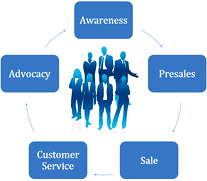With mounting regulatory pressure to reduce service fees, retail banks and credit unions are increasingly looking to build stronger customer relationships to drive revenue growth. Amid a rapidly changing business environment – new non-bank competitors, new substitute products, and changing customer demographics – financial institutions (FIs) need to better understand how to optimize their customer experience.
One effective strategy is to leverage the survey data you already collect to serve as the cornerstone for your Voice of the Customer (VOC) programs.
To help ensure you’re capturing insights that reflect your customer’s overall experience with your FI, consider the following approaches to broaden your survey strategy. You can then channel your survey data into a VOC analytics platform to develop valuable insights and action plans for making measurable improvements in customer experience.
Build more value into your customer surveys

Listen to your customers throughout the customer lifecycle
You can collect large amounts of customer feedback data across the customer lifecycle, tracking five key stages: awareness, presales, sale, customer service and advocacy.
Your surveying strategy, including what questions you ask and when you ask them, will depend on your priorities. For example, with a business line of credit customer, you might solicit feedback after an initial review, survey how they felt about the closing process, and later survey how well your bank is meeting their ongoing servicing needs.
Open-ended questions are especially valuable, giving you meaningful, descriptive data in the customer’s own words. Surveys can help you to, in effect, measure the quality of your service.
Analyze customer insights with the proper business context
Surveys enable your organization to acquire insights focused on three key areas: customer satisfaction, customer loyalty, and your financial institution’s competitive positioning in the market.
-
Leverage surveys to analyze customer satisfaction
An effective customer satisfaction survey should address a variety of interactions that consumers have with your bank. In particular, your surveys should measure customer perceptions of how well the company delivers on key metrics across the business, including service, sales, product direction and more.
-
Tap surveys to gain insights about brand loyalty
In addition to measuring customer satisfaction as part of your Voice of the Customer efforts, it’s important to also survey to gain insights on brand loyalty. Capture feedback on factors that drive loyalty (what customers value most about your financial institution) as well as evidence of existing brand loyalty (whether they recommend you to others, and are receptive to cross-sell offerings).Brand loyalty is about more than service experiences; it’s about emotional connection with your company, so try to measure that. For example, if your bank or credit union is actively engaging on Facebook and YouTube to build community with younger audiences, surveys can help you measure the effectiveness of those efforts.
-
Implement surveys to manage the competition
Another key consideration in your Voice of the Customer efforts is understanding how your business compares against the competition. Surveys can help you gain insights about:
- What types of customers are attracted to your financial institution, and why
- Customer purchasing patterns: where, how and why they buy from you
- How your services are differentiated from the competition
Act on insights from survey data
-
Individual customer feedback
Customer feedback provides valuable information to your financial institution, and research shows that acknowledging that feedback often strengthens relationships and builds loyalty. Whenever possible, show customers you value their opinions by responding to feedback promptly with a personalized note of appreciation.
-
Aggregate customer insights
Analyzing large volumes of customer survey data, especially with text analytics for verbatim comments, can unlock real value by uncovering actionable insights on how to improve the customer experience. For example, survey comments might indicate prevalent issues with online banking, and thus, help you target changes that customers will value most.
-
Organizational impact
Acting on survey feedback to improve the customer experience is great for business, but it may also mean organizational changes. An effective strategy for surveys (and VOC in general) is to be prepared for impacts on processes, systems, communications, and even customer-facing personnel. Suppose surveys highlight a strong need to offer wire transfer services through online banking. Your internet services team will need to build a new system, IT will need to manage security issues, and service teams monitoring call centers and email will need training on how the new tools work and how to support customers.
Putting the Voice of the Customer to use
Companies that capture and act on Voice of the Customer insights build stronger relationships, maintain higher customer retention rates, and foster deeper brand loyalty. Year after year, these businesses also earn higher sales, while spending significantly less on customer acquisition than their competition.
By taking full advantage of surveys to spearhead your VOC efforts, your financial institution has the opportunity to create a differentiated experience that achieves a high overall customer satisfaction, drives customer loyalty, and increases competitive market share.

